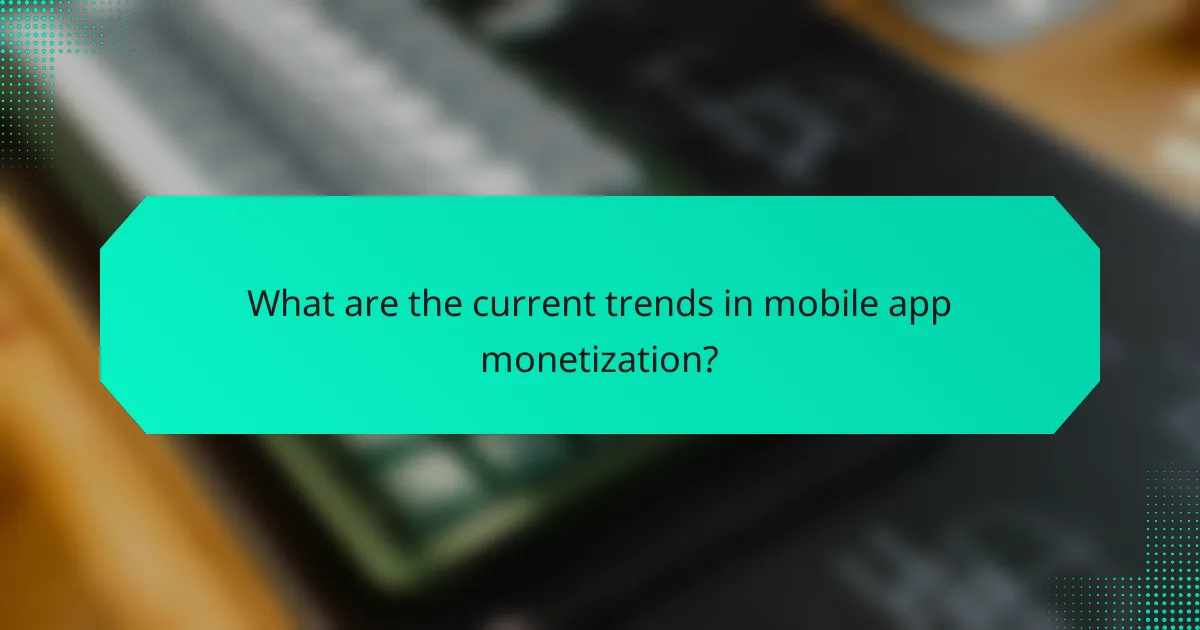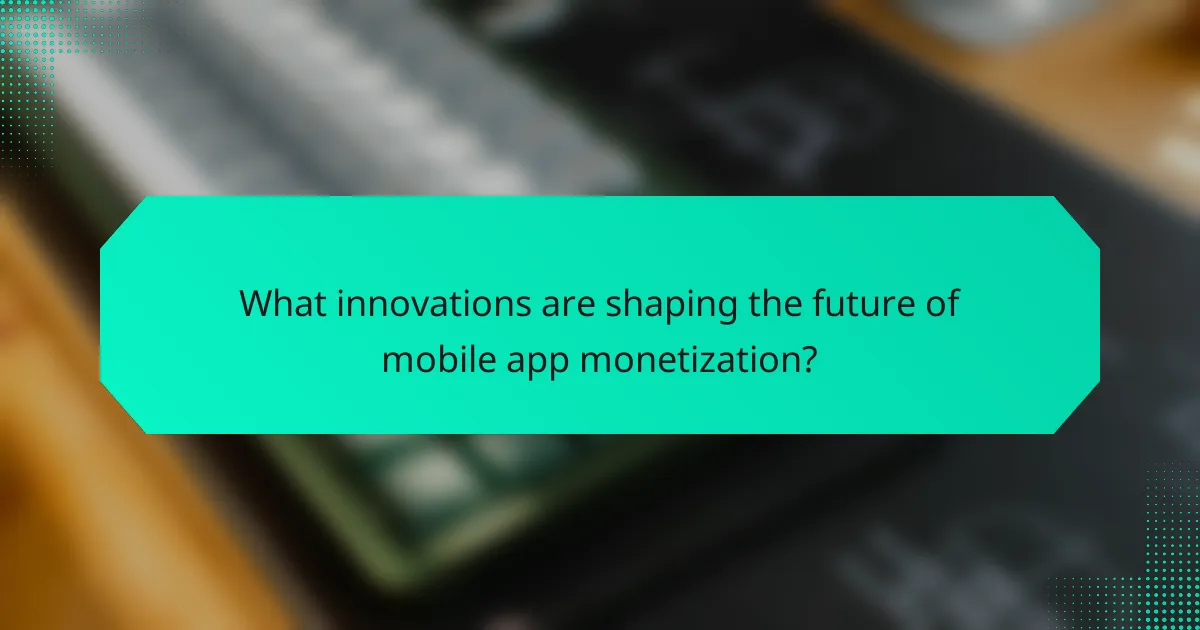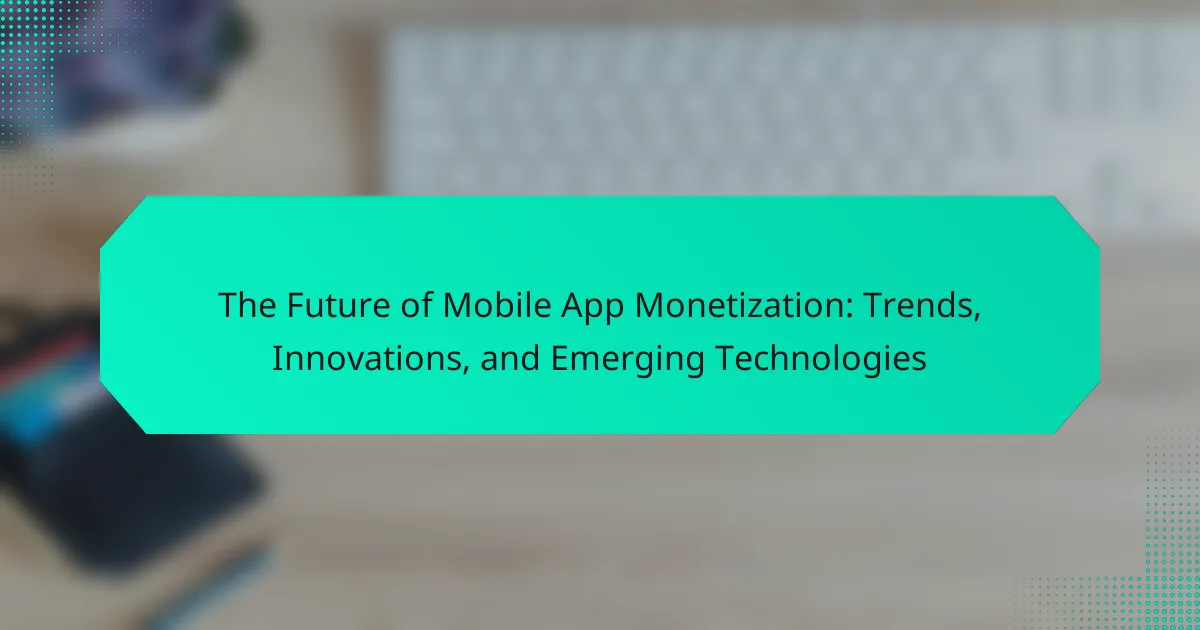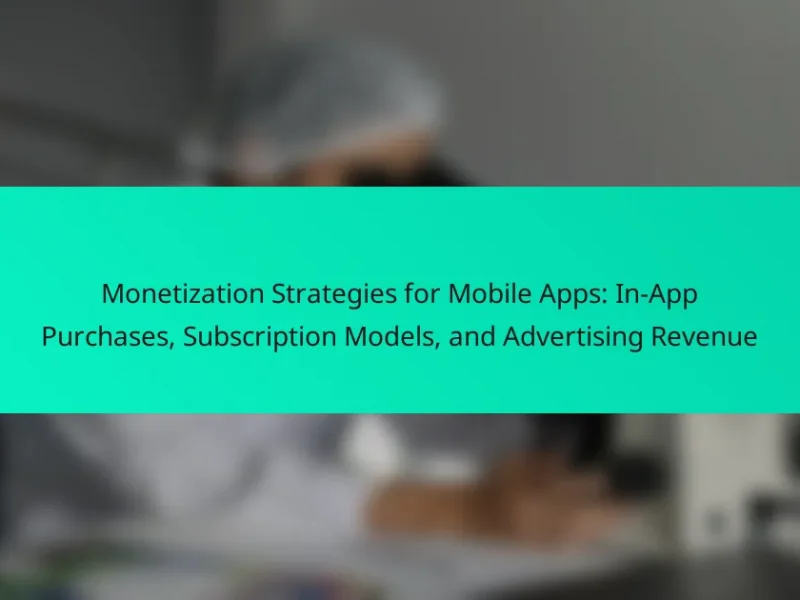Mobile app monetization refers to the strategies employed to generate revenue from mobile applications, including in-app purchases, subscriptions, and advertising. This article examines current trends such as the rise of subscription models, which have become a significant source of revenue, and the continued success of in-app purchases, particularly in gaming. Additionally, it explores the evolution of ad monetization techniques, focusing on personalized ads and the impact of emerging technologies like blockchain on revenue generation. The insights provided highlight the dynamic landscape of mobile app monetization and the importance for developers to adapt to these innovations.

What is Mobile App Monetization?
Mobile app monetization is the process of generating revenue from a mobile application. It involves various strategies such as in-app purchases, subscriptions, and advertising. In-app purchases allow users to buy virtual goods or features within the app. Subscriptions provide ongoing access to premium content or services for a recurring fee. Advertising generates revenue by displaying ads to users, often through networks like Google AdMob. According to Statista, mobile app revenue is projected to reach over $407 billion by 2026, highlighting the importance of effective monetization strategies.
How does mobile app monetization work?
Mobile app monetization works by generating revenue through various strategies. Common methods include in-app purchases, subscription models, and advertisements. In-app purchases allow users to buy virtual goods or features within the app. Subscription models charge users a recurring fee for access to premium content or services. Advertisements generate income by displaying ads from third parties within the app. According to Statista, mobile app revenue from in-app purchases is projected to reach $189 billion by 2024. This indicates that monetization strategies are essential for app developers to sustain their businesses.
What are the primary monetization models used in mobile apps?
The primary monetization models used in mobile apps are in-app purchases, subscription services, advertising, and paid apps. In-app purchases allow users to buy virtual goods or features within the app. Subscription services charge users a recurring fee for access to content or services. Advertising generates revenue by displaying ads to users, often through partnerships with ad networks. Paid apps require users to pay a one-time fee to download the app. According to Statista, in-app purchases accounted for over 50% of global app revenue in 2021, highlighting their significance in the mobile app ecosystem.
How do user demographics influence monetization strategies?
User demographics significantly influence monetization strategies in mobile apps. Different age groups, income levels, and geographic locations affect user spending behaviors. For instance, younger users may prefer in-app purchases or subscriptions, while older users might favor ad-supported models. Income levels dictate how much users are willing to spend on apps. High-income users often engage with premium features, while budget-conscious users may opt for free versions. Geographic differences also play a role; users in developed regions typically have higher spending potential compared to those in developing areas. Research shows that apps targeting specific demographics can tailor their monetization strategies effectively, leading to increased revenue.
Why is mobile app monetization important for developers?
Mobile app monetization is crucial for developers because it directly impacts their revenue generation. Developers invest significant time and resources into creating apps. Monetization strategies enable them to recoup these investments and earn profits. According to Statista, global app revenue is projected to reach over $407 billion by 2026. This substantial market opportunity incentivizes developers to implement effective monetization methods. Additionally, successful monetization can enhance user engagement and retention. By offering premium features or ad-supported models, developers can create sustainable business models. Thus, mobile app monetization is essential for the financial viability of app development.
What financial benefits do developers gain from effective monetization?
Developers gain increased revenue from effective monetization strategies. This can include higher earnings from in-app purchases and subscriptions. Effective monetization can also lead to better user retention rates. A study by Statista found that mobile app revenue is projected to reach $407.31 billion by 2026. Additionally, monetization can enhance brand visibility and attract more users. Successful monetization strategies often lead to improved investment opportunities. Developers can leverage analytics to optimize their monetization approaches. This results in a more sustainable financial model over time.
How does monetization impact app development and user experience?
Monetization significantly impacts app development and user experience. Developers often prioritize features that drive revenue, such as ads and in-app purchases. This focus can lead to a more aggressive marketing approach within the app. Consequently, user experience may suffer due to intrusive ads or limited access to features unless users pay.
Research indicates that 70% of users abandon apps due to poor monetization strategies. Furthermore, a balance is essential; apps that offer value while monetizing effectively retain users better. For example, successful freemium models provide core features for free, enhancing user engagement while still generating revenue.
In summary, effective monetization shapes app development priorities and directly influences user satisfaction and retention.

What are the current trends in mobile app monetization?
Current trends in mobile app monetization include subscription models, in-app purchases, and ad monetization. Subscription models have gained popularity due to their predictable revenue streams. According to a report by App Annie, 2019 saw a 20% increase in subscription-based apps. In-app purchases continue to thrive, especially in gaming apps, driving significant revenue. Ad monetization strategies have evolved, with increased focus on personalized ads and user engagement. The rise of video ads and rewarded ads has also been notable. Furthermore, the integration of blockchain technology is emerging as a trend, offering new monetization avenues. These trends reflect the dynamic nature of the mobile app market and the need for developers to adapt.
How is user engagement affecting monetization trends?
User engagement significantly influences monetization trends in mobile apps. Higher user engagement typically leads to increased in-app purchases and ad revenue. Engaged users are more likely to spend money on premium features or subscriptions. According to a report by App Annie, apps with high engagement see a 200% increase in revenue compared to those with low engagement. Additionally, engaged users often contribute to higher retention rates, which positively impacts lifetime value. This correlation suggests that developers should prioritize user engagement strategies to enhance monetization outcomes.
What role does personalization play in enhancing user engagement?
Personalization significantly enhances user engagement by tailoring experiences to individual preferences. Users are more likely to interact with content that resonates with their interests. Personalized recommendations can lead to increased usage and retention rates. According to a study by Epsilon, 80% of consumers are more likely to make a purchase when brands offer personalized experiences. Additionally, personalization fosters a sense of connection between users and the app. This connection can result in higher satisfaction and loyalty. Ultimately, personalized experiences drive user engagement by making interactions more relevant and enjoyable.
How are subscription models changing the landscape of monetization?
Subscription models are transforming monetization by providing predictable revenue streams for businesses. This model encourages customer loyalty through continuous access to services or products. Companies can better forecast earnings, which aids in strategic planning. According to a report by Zuora, subscription businesses grow revenues about 5 times faster than traditional models. Additionally, subscription models reduce customer acquisition costs over time. They also foster a direct relationship between businesses and consumers. This shift allows for personalized experiences, enhancing customer satisfaction. Overall, subscription models are reshaping how companies approach revenue generation and customer engagement.
What emerging technologies are influencing mobile app monetization?
Emerging technologies influencing mobile app monetization include artificial intelligence, blockchain, and augmented reality. Artificial intelligence enhances user experience through personalized ads and recommendations. This can lead to increased user engagement and higher revenue. Blockchain technology offers transparency and security in transactions. It can reduce fraud and increase trust in in-app purchases. Augmented reality creates immersive experiences that can drive user spending. These technologies are reshaping how developers monetize their apps, leading to innovative revenue streams.
How is artificial intelligence being utilized in monetization strategies?
Artificial intelligence is utilized in monetization strategies by enabling personalized advertising and dynamic pricing. AI algorithms analyze user behavior and preferences to deliver targeted ads. This increases user engagement and conversion rates. Dynamic pricing models adjust in real-time based on demand and user data. For example, companies like Uber use AI to optimize fares based on location and demand patterns. Additionally, AI enhances user experience through recommendation systems. These systems suggest relevant in-app purchases or subscriptions. Research from McKinsey indicates that businesses using AI for personalization can see up to a 10-30% increase in revenue. Thus, AI significantly boosts the effectiveness of monetization strategies in mobile apps.
What impact does blockchain technology have on app monetization?
Blockchain technology significantly enhances app monetization by enabling decentralized transactions. This decentralization reduces reliance on traditional payment processors, lowering transaction fees. Smart contracts automate payment processes, ensuring timely and secure transactions. Users gain more control over their data, fostering trust and loyalty. Blockchain also introduces tokenization, allowing developers to create unique in-app currencies. This can lead to new revenue streams through token sales and rewards. A study by Deloitte found that 40% of companies believe blockchain will disrupt their business models. Thus, blockchain’s impact on app monetization is profound and transformative.

What innovations are shaping the future of mobile app monetization?
Innovations shaping the future of mobile app monetization include subscription models, in-app purchases, and ad personalization. Subscription models provide consistent revenue streams. This approach has gained traction, with over 50% of app revenue coming from subscriptions in 2021. In-app purchases allow users to buy digital goods directly. This model enhances user engagement and boosts revenue. Ad personalization leverages user data to serve targeted ads. It increases ad effectiveness and user satisfaction. Emerging technologies like blockchain are also influencing monetization. They offer secure transactions and new revenue opportunities through decentralized applications. Overall, these innovations are transforming how developers monetize mobile applications.
How are in-app purchases evolving with new technologies?
In-app purchases are evolving through advancements in technology. New payment systems, like cryptocurrency, are being integrated into mobile apps. This offers users more options and flexibility. Augmented reality (AR) enhances user experience, making in-app purchases more engaging. Machine learning algorithms personalize suggestions, increasing conversion rates for in-app purchases. Subscription models are gaining popularity, providing steady revenue streams. Data analytics help developers optimize pricing strategies. These technological trends are reshaping how users interact with in-app purchases.
What are the latest developments in virtual and augmented reality monetization?
The latest developments in virtual and augmented reality monetization include the rise of subscription models and in-app purchases. Companies are increasingly adopting subscription services for VR and AR content. This allows users to access a library of experiences for a recurring fee. In-app purchases are also gaining traction. Users can buy virtual goods or enhancements within experiences.
Advertising within VR and AR environments is becoming more sophisticated. Brands are investing in immersive advertising strategies. These strategies engage users in a way traditional ads cannot.
Moreover, the integration of blockchain technology is emerging. This allows for secure transactions and ownership verification of virtual assets. A report by PwC highlights that the global VR and AR market could reach $1.5 trillion by 2030. This growth indicates significant monetization potential for developers and businesses.
How can developers leverage gamification to boost monetization?
Developers can leverage gamification to boost monetization by integrating game-like elements into their applications. This approach enhances user engagement and encourages repeat interactions. Features like rewards, leaderboards, and challenges motivate users to spend more time in the app. According to a study by the University of California, gamification can increase user retention by up to 30%. Additionally, developers can implement in-app purchases tied to gamified experiences, such as exclusive items or levels. This strategy directly correlates with increased revenue. Companies like Duolingo and Fitbit have successfully utilized gamification to drive user investment and monetization.
What challenges do developers face in mobile app monetization?
Developers face several challenges in mobile app monetization. One major challenge is user acquisition costs, which can be high in competitive markets. According to a report by App Annie, the average cost to acquire a user can exceed $4 in certain app categories. Another challenge is balancing monetization strategies with user experience. Implementing ads or in-app purchases can lead to user dissatisfaction and increased churn rates. Additionally, developers must navigate app store policies, which can restrict monetization options. For instance, Apple’s App Store guidelines have specific rules regarding subscriptions and in-app purchases. Finally, market saturation makes it difficult for new apps to stand out and generate revenue. A study by Sensor Tower shows that over 2 million apps are available in the Apple App Store alone, increasing competition.
How do privacy regulations affect monetization strategies?
Privacy regulations significantly impact monetization strategies by limiting data collection and usage. These regulations, such as GDPR and CCPA, enforce strict guidelines on how user data can be collected and shared. As a result, businesses must adapt their strategies to comply with these laws. They may shift towards first-party data collection methods, which are generally permissible under regulations. Additionally, companies may invest more in transparent user consent mechanisms to ensure compliance. This shift can lead to reduced advertising revenue, as targeted advertising relies heavily on user data. Furthermore, businesses may explore alternative monetization models, such as subscription services or in-app purchases, to mitigate revenue loss. Overall, privacy regulations necessitate a reevaluation of traditional monetization approaches in mobile app development.
What are the common pitfalls to avoid in mobile app monetization?
Common pitfalls to avoid in mobile app monetization include overloading users with ads. Excessive advertisements can lead to user frustration and app abandonment. Another pitfall is neglecting user experience. Prioritizing monetization over usability can drive users away. Additionally, failing to understand the target audience can result in ineffective monetization strategies. Poorly chosen monetization models may not align with user expectations. Moreover, not optimizing for various devices can limit revenue potential. Lastly, ignoring data analytics can prevent informed decision-making. According to a study by App Annie, apps that balance monetization and user experience retain users better.
What best practices should developers follow for successful monetization?
Developers should implement a freemium model for successful monetization. This approach allows users to access basic features for free while offering premium features at a cost. Research indicates that 90% of app revenue comes from freemium models. Developers should also focus on user engagement to maximize retention. Engaged users are more likely to convert to paying customers. Data shows that apps with high engagement rates see a 20-40% increase in revenue. Additionally, optimizing in-app purchases can significantly boost earnings. Offering limited-time discounts or exclusive content can entice users to make purchases. Finally, analyzing user behavior through analytics can inform monetization strategies. Tailoring offerings based on user preferences leads to higher conversion rates.
How can developers effectively analyze user data for better monetization?
Developers can effectively analyze user data for better monetization by employing data analytics tools and techniques. These tools can help identify user behavior patterns and preferences. By segmenting users based on their interactions, developers can tailor monetization strategies. For example, targeting high-value users with exclusive offers can increase conversion rates. Additionally, A/B testing different monetization models can provide insights into what works best. Utilizing metrics such as Customer Lifetime Value (CLV) and churn rates informs developers about user engagement and retention. According to a study by AppsFlyer, apps that leverage data analytics see a 20% increase in revenue. This demonstrates the effectiveness of data-driven decision-making in enhancing monetization strategies.
What strategies can enhance user retention and increase revenue?
Implementing personalized user experiences enhances user retention and increases revenue. Personalization can include tailored content, recommendations, and targeted offers. Data shows that personalized experiences can lead to a 10% increase in user engagement. Utilizing push notifications effectively can also boost retention. Research indicates that apps using personalized push notifications see up to a 4x higher open rate. Offering loyalty programs encourages repeat usage and can increase customer lifetime value. According to a study by Bond Brand Loyalty, 79% of consumers are more likely to continue doing business with brands that offer loyalty programs. Enhancing user onboarding processes ensures that users understand app features, leading to better retention rates. A smooth onboarding experience can increase retention by 50% in the first week. Regularly updating content and features keeps users engaged and encourages them to return. Apps that frequently update their content can see a 20% increase in user retention.
The main entity of the article is mobile app monetization, which refers to the strategies used to generate revenue from mobile applications. The article provides an overview of various monetization models, including in-app purchases, subscriptions, and advertising, highlighting their importance for developers in sustaining their businesses. It discusses user demographics, current trends, and the impact of emerging technologies like artificial intelligence and blockchain on monetization strategies. Additionally, the article addresses challenges developers face, best practices for successful monetization, and the significance of user engagement and personalization in enhancing revenue.


